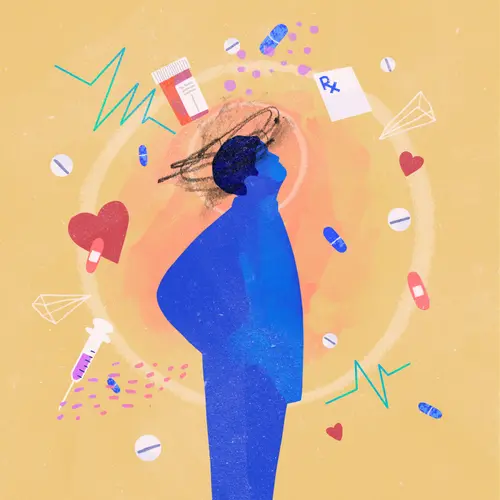A panic attack is a sudden feeling of overwhelming fear or distress that includes physical symptoms. The sensations usually peak at around 10 minutes after onset and go away quickly. A diagnosis typically relies on the patient's description, since the symptoms usually disappear before a health professional can observe them.
Sometimes, people use the terms "anxiety attack" and "panic attack" interchangeably, but they aren't really the same thing. Everyone experiences anxiety, sometimes at high levels. The sudden onset of intense feelings along with physical symptoms is a different thing and is properly labeled as a panic attack.
Around 11% of adults have a panic attack each year. If you have repeated panic attacks, you may have panic disorder, especially if you have changed your behavior to avoid triggering an attack. Drugs and psychotherapy are the major paths of treatment. Left untreated, panic disorder can turn into agoraphobia, in which people are afraid of leaving their homes because they might face a stressful situation. Many of those with agoraphobia have difficulty riding in elevators, using public transportation, standing in line, and coping with other everyday situations.
Types of Panic Attacks
There are two basic types of panic attacks, expected and unexpected. Expected panic attacks occur when you are facing a situation that has caused you problems in the past. Sometimes, expected attacks are triggered by a phobia or by a genuinely stressful event, such as taking a difficult exam. When unexpected attacks occur, you can't identify an external trigger. Unexpected panic attacks account for about 40% of the total.
Signs of a Panic Attack
There are 13 recognized signs of a possible panic attack. Four are required for a panic attack diagnosis. These signs include physical and emotional symptoms:
Physical Symptoms of a Panic Attack
The physical symptoms of a panic attack are caused by the body's "fight or flight" reaction to stress. Because the physical symptoms of a panic attack are so severe, people often believe that they are having a heart attack. Those with a known heart condition who experience these symptoms should seek medical care immediately. Those who suffer a panic attack should have their heart health evaluated to be sure their symptoms aren't cardiac in nature.
These are the physical symptoms of panic attack:
- Palpitations, pounding heart, or fast heart rate
- Sweating
- Trembling or shaking
- Sensations of shortness of breath or being smothered
- Feeling of choking
- Chest pain or discomfort
- Nausea or abdominal distress
- Feeling dizzy, unsteady, lightheaded, or faint
- Numbness or tingling
- Chills or sensations of heat
Psychological Symptoms of a Panic Attack
These are the psychological symptoms of panic attack:
- Feelings of unreality or being detached from oneself
- Fear of losing control or going crazy
- Fear of dying
Any combination of four symptoms, either physical or psychological, can lead to a panic attack diagnosis. Some people have episodes with the same symptoms as panic attacks but with fewer than four symptoms. These are known as limited-symptom attacks.
Dealing With Panic Attacks
If you are able to return to the situation or the scene of previous attacks without panicking, your prognosis improves. If, on the other hand, you have changed your life to avoid triggering experiences, you may need professional help. Treatment of panic attacks and panic disorder usually consists of:
Drug Therapy
Your health care provider may prescribe antidepressants or antianxiety medicines to treat panic disorder. Antidepressants have fewer side effects, but antianxiety drugs such as benzodiazepines may be more effective. Some patients may take both types of drugs at first.
Psychotherapy
Several types of psychotherapy can be effective against panic disorders. In exposure therapy, you are encouraged to confront whatever triggers your attacks. The exposure is gradual and controlled, so you can learn to handle the anxiety. In cognitive-behavioral therapy, you learn to recognize your unfounded fears and practice coping techniques such as slow breathing. In supportive therapy, you are educated about your condition and given emotional support.
Self-Help
It's possible to learn to prevent a panic attack. Many people benefit from breathing exercises and other calming techniques. You can find apps to help you with these practices. These self-help methods are often used with other treatments. Proper diet and exercise can be helpful. It also helps to avoid alcohol, cigarettes, and caffeine, as these can add to stress levels.
Support and Resources
If you have panic attacks or panic disorder, you should see a doctor, but these resources may also be helpful:
From the ADAA
The Anxiety and Depression Association of America (ADAA) has several resources on their website, including book recommendations. They also have ratings for several helpful apps.
From the NIH
The National Institute of Mental Health has a page of helpful links with information about finding a clinical trial, treatment center, or other sources for help.
From the Mental Health Foundation
The UK's Mental Health Foundation has several resources about panic disorders, including links to helpful organizations, a mindfulness course, and an app library.

